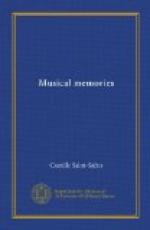But the best was at the end of the second act. The forest with its trees, grass and rocks entirely disappeared in the flies taking Renaud and Armide with it and the spectator was left, for some unknown reason, looking at a background surrounded by mountains. Then, by a marvel of mechanism, there appeared to the sound of ultramodern music, Renaud sleeping on a bed of state, with Armide standing at the foot and stretching forth her hand with a gesture of authority, declaiming in a solemn tone,
“Rinaldo, I love you!”
and the curtain fell to the applause of the audience.
* * * * *
We owe much to Germany in music, for it has produced many great musicians. It can set off against our trinity of Corneille, Racine, and Moliere, the no less glorious Haydn, Mozart and Beethoven. But Germany seems to have lost all respect for the meaning of its own music and for its own glories. Instead of watching over the purity of the text of its masterpieces, it alters them at its pleasure and makes them all but unrecognizable. We abuse nuances but they were rare in earlier days. An orchestra conductor who performs symphonies by Haydn and Mozart, even by Beethoven, has the right to make additions. But it is intolerable that the scores should be printed with these nuances and bowings which are in no way due to the author and which are imposed by the editor. Nevertheless, that is what happens, and it is impossible to tell where the authentic text ends and the interpolation begins. In addition, the interpolation may be the exact contrary of what the author intended.
This evil is at its worst in piano music. Our famous teachers, like Marmontel and Le Couppey, have published editions of the classics which are full of their own directions. But the player is forewarned; it is the Marmontel or Le Couppey edition and makes no pretence of authenticity. In Germany, however, there are supposedly authentic editions, based on the originals, but which superimpose their own pernicious inventions on the author’s text.
The touch of the piano used to be different from what it is to-day. The directions in Mozart’s and Beethoven’s works show that they used the execution of stringed instruments as their model. The touch was lighter and the fingers were raised so that the notes were separated slightly, and not run together except when indicated. The supposition is that this must have led to a dryness of tone. I remember to have heard in my childhood some old people whose playing was singularly hopping. Then, there came a reaction, and with it a passion for slurring the notes. When I was Stamaty’s pupil, it was considered most difficult to “tie” the notes; that required, however, only dexterity and suppleness. “When she learns to ‘tie,’ she will know how to play,” said the mother of a young pianist. Nevertheless, the trick of perpetual legato becomes exceedingly monotonous and takes away all character from the pianoforte classics. But it is insisted on everywhere in the modern German editions. Throughout there are connections seemingly interminable in length, and indications of legato, sempre legato, which the author not only did not indicate, but in places where it is easy to see that he intended the exact opposite.




